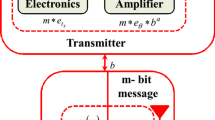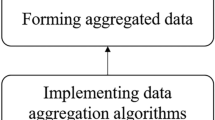Abstract
There is a developing effect of WSNs (wireless Sensor Networks) on genuine applications. Various plans have been proposed for gathering information on multipath routing, tree, clustering and cluster trees. Existing schemes can’t give an ensured dependable system to versatility, movement, and end-to-end association, separately. Such kind of problems to be moderate, the proposed scheme considers a densely distributed WSN system model related to Internet-of-Things (IoT) and tree based cluster formation depending upon sensor node deployment density. For each tree based cluster having one cluster head node to attain energy efficient data gathering, a reinforcement learning based fuzzy inference system (RL-FIS) will applied to determine the data gathering node for every cluster present in the densely distributed WSNs based on three metrics: neighbourhood overlap, bipartivity index and algebraic connectivity. We compare our proposed scheme with the other schemes. Simulation results indicate that our proposed scheme outperform the other schemes in overall energy consumption saving and prolong the lifetime of the network.










Similar content being viewed by others
Change history
13 December 2022
This article has been retracted. Please see the Retraction Notice for more detail: https://doi.org/10.1007/s11277-022-10144-y
References
Hoang, D. C., Yadav, P., Kumar, R., & Panda, S. K. (2014). Real-time implementation of a harmony search algorithm-based clustering protocol for energy-efficient wireless sensor networks. IEEE Transactions on Industrial Informatics, 10(1), 774–783.
Zheng, J., Bhuiyan, M. Z., Liang, S., Xing, X., & Wang, G. (2014). Auction-based adaptive sensor activation algorithm for target tracking in wireless sensor networks. Future Generation Computer Systems, 39, 88–99.
Shen, H., & Bai, G. (2016). Routing in wireless multimedia sensor networks: A survey and challenges ahead. Journal of Network and Computer Applications, 71, 30–49.
Abdollahzadeh, S., & Navimipour, N. J. (2016). Deployment strategies in the wireless sensor network: A comprehensive review. Computer Communications, 91, 1–6.
Gu, Y., Ren, F., Ji, Y., & Li, J. (2016). The evolution of sink mobility management in wireless sensor networks: A survey. IEEE Communications Surveys & Tutorials., 18(1), 507–524.
Bhuiyan, M. Z., Wang, G., & Vasilakos, A. V. (2015). Local area prediction-based mobile target tracking in wireless sensor networks. IEEE Transactions on Computers, 64(7), 1968–1982.
Kobo, H. I., Abu-Mahfouz, A. M., & Hancke, G. P. (2017). A survey on software-defined wireless sensor networks: Challenges and design requirements. IEEE Access, 5, 1872–1899.
Rathore, H., Badarla, V., & Shit, S. (2016). Consensus-aware sociopsychological trust model for wireless sensor networks. ACM Transactions on Sensor Networks (TOSN)., 12(3), 21.
Ren, J., Zhang, Y., Zhang, K., Liu, A., Chen, J., & Shen, X. S. (2016). Lifetime and energy hole evolution analysis in data-gathering wireless sensor networks. IEEE Transactions on Industrial Informatics, 12(2), 788–800.
Kaswan, A., Nitesh, K., & Jana, P. K. (2017). Energy efficient path selection for mobile sinkand data gathering in wireless sensor networks. AEU-International Journal of Electronics and Communications, 73(1), 110–118.
Logambigai, R., & Kannan, A. (2016). Fuzzy logic based unequal clustering for wireless sensor networks. Wireless Networks, 22(3), 945–957.
Abbasi-Daresari, S., & Abouei, J. (2016). Toward cluster-based weighted compressive data aggregation in wireless sensor networks. Ad Hoc Networks, 36, 368–385.
Zhang, D., Zhou, Z., Mumtaz, S., Rodriguez, J., & Sato, T. (2016). One integrated energy efficiency proposal for 5G IoT communications. IEEE Internet of Things Journal, 3(6), 1346–1354.
Xie, R., & Jia, X. (2014). Transmission-efficient clustering method for wireless sensor networks using compressive sensing. IEEE Transactions on Parallel and Distributed Systems, 25(3), 806–815.
Wang, C. F., Shih, J. D., Pan, B. H., & Wu, T. Y. (2014). A network lifetime enhancement method for sink relocation and its analysis in wireless sensor networks. IEEE Sensors Journal, 14(6), 1932–1943.
Dong, M., Ota, K., & Liu, A. (2016). RMER: Reliable and energy-efficient data collection for large-scale wireless sensor networks. IEEE Internet of Things Journal, 3(4), 511–519.
Haseeb, K., Bakar, K. A., Abdullah, A. H., & Darwish, T. (2017). Adaptive energy aware cluster-based routing protocol for wireless sensor networks. Wireless Networks, 23(6), 1953–1966.
Velmani, R., & Kaarthick, B. (2015). An efficient cluster-tree based data collection scheme for large mobile wireless sensor networks. IEEE Sensors Journal, 15(4), 2377–2390.
Biason, A., Pielli, C., Rossi, M., Zanella, A., Zordan, D., Kelly, M., et al. (2017). EC-CENTRIC: An energy-and context-centric perspective on IoT systems and protocol design. IEEE Access, 10, 2169–3536.
Nguyen, T. D., Khan, J. Y., & Ngo, D. T. (2017). Energy harvested roadside IEEE 802.15. 4 wireless sensor networks for IoT applications. Ad Hoc Networks, 56, 109–121.
Suresh, A., Reyana, A., & Varatharajan, R. (2018). CEMulti-core architecture for optimization of energy over heterogeneous environment with high performance smart sensor devices. Wireless Personal Communications. https://doi.org/10.1007/s11277-018-5504-0.
Author information
Authors and Affiliations
Corresponding author
Additional information
Publisher's Note
Springer Nature remains neutral with regard to jurisdictional claims in published maps and institutional affiliations.
About this article
Cite this article
Sathya Lakshmi Preetha, S.K., Dhanalakshmi, R. & Kumar, R. RETRACTED ARTICLE: An Energy Efficient Framework for Densely Distributed WSNs IoT Devices Based on Tree Based Robust Cluster Head. Wireless Pers Commun 103, 3163–3180 (2018). https://doi.org/10.1007/s11277-018-6000-2
Published:
Issue Date:
DOI: https://doi.org/10.1007/s11277-018-6000-2




